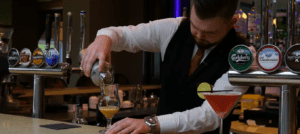The Uilleann Pipes: Unveiling Ireland’s Distinct Musical Heritage
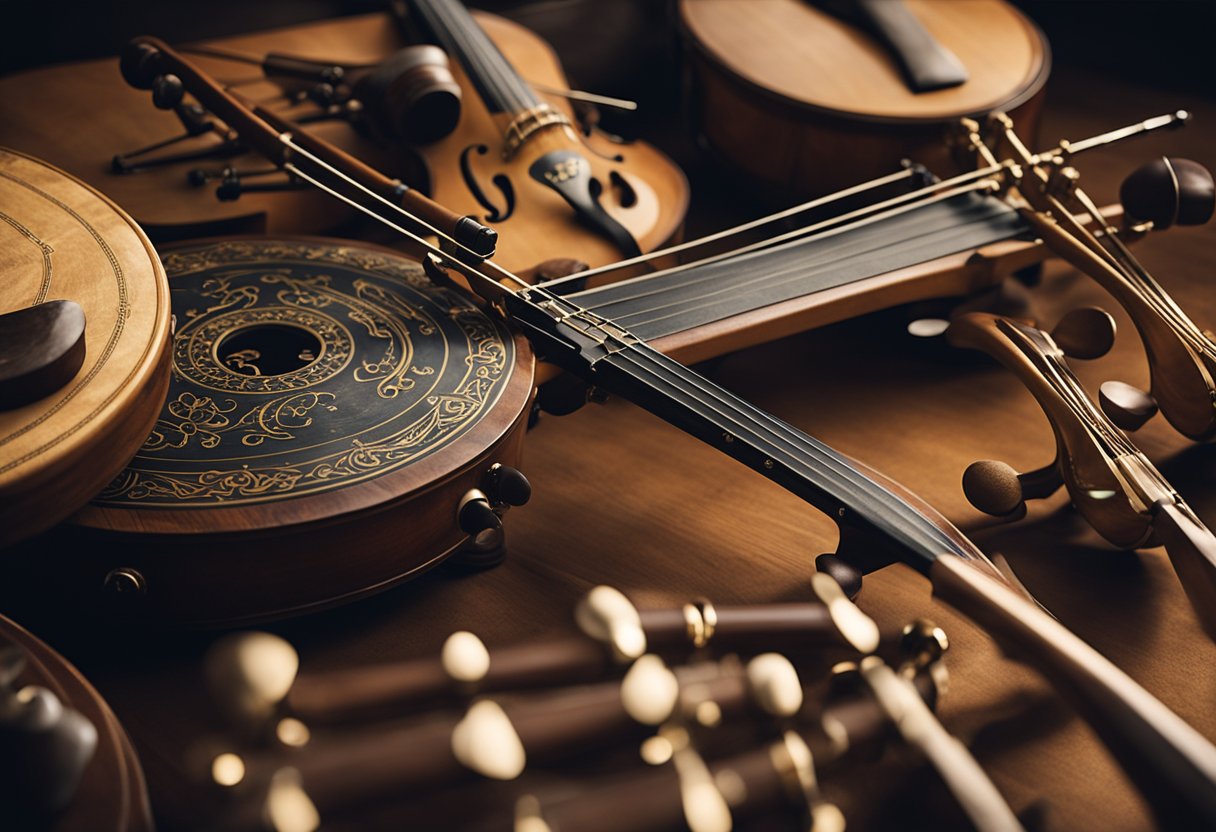
Updated On: April 22, 2024 by Maha Yassin
The Uilleann Pipes are Ireland’s distinctive musical offering to the world’s soundscape. Originating in the 18th century, these instruments are famed for their complex design and the mellifluous music they produce. Unlike their counterparts, the Uilleann Pipes are played with bellows under the arm—allowing for a more controlled, sweeter tone that has come to characterise traditional Irish music. Their intricate melody lines and the ability to achieve a range of dynamics make them a soul-stirring addition to contemporary and classical compositions.
Through time, the Uilleann Pipes have become deeply embedded in the cultural identity of Ireland, with a rich legacy perpetuated by masterful musicians and dedicated craftsmen. We see their influence not just confined to the shores of Ireland but extending globally as an instrument of profound expressiveness and versatility. The unique tonal qualities and the emotive range of the pipes resonate with music enthusiasts worldwide, ensuring their place in the diverse spectrum of world music.
History of the Uilleann Pipes
The origins of the uilleann pipes stretch back to medieval times. Although less is known about this period, the instrument as we recognise it today began to take shape during the 18th century in Ireland. The uilleann pipes are a distinct form of bellows-blown bagpipes and are a key aspect of Irish traditional music.
In the 1700s, pipe modifications led to a design requiring the player to sit while playing, as the complex set—with its regulators—rested across the knees. This layout likely became standard between the 1750s and 1760s. A pivotal moment in developing the uilleann pipes was the addition of the regulators—keys that allow the performer to play chords and harmonics.
The oldest surviving sets of uilleann pipes, resembling the Scottish Highland bagpipes and Northumbrian small pipes, date back to the late 1700s. This period was also significant for the invention of the regulator, which further differentiated the uilleann pipes from other bagpipes.
The name “uilleann” comes from the Irish term “uillinn,” which means “elbow,” signifying the use of the elbow to pump the bellows. The full Irish term is “píb uilleann, ” meaning “pipes of the elbows.”
Throughout their development, uilleann pipes have retained a complex structure comprised of a bag, bellows, chanter, regulators, and drones. The playing technique involves precise posture, hand placement, and command over various ornamentations, reflecting the instrument’s intricacies and place in conveying the depth of Irish music heritage.
Design and Mechanics
When we consider the Uilleann Pipes, Ireland’s signature bagpipe, it’s evident that their distinctive design and mechanics contribute significantly to their unique sound. The Uilleann Pipes showcase meticulous craftsmanship, where wood, leather, and cork harmonise. Let’s look closer at the specific components and how they’re tuned to make this instrument so enchanting.
Components and Construction
The Uilleann Pipes are composed of several key parts, each crafted precisely. The bag is traditionally made of leather and serves as an air reservoir pumped by the bellows, which the player operates with the arm. The chanter is the melody pipe played by the fingers, usually fashioned from woods such as ebony or blackwood. Accompanying the channel are the drones and regulators. Drones provide a constant harmonic background, while regulators allow for chordal accompaniment, adding layers to the music. These parts are connected using cork and are assembled to work together seamlessly.
Reeds and Tuning
The reeds are the key to the Uilleann Pipes’ sound. The chanter and regulators use a double reed, similar to that of an oboe, while the drones use single reeds. The precision in crafting these reeds is critical for their proper pitch and tone. Tuning the Uilleann Pipes is an art in itself, with the chanter being tuned first, followed by the regulators and drones to ensure they’re in harmony. The reeds are sensitive to changes in temperature and humidity, so pipers must carefully adjust them to maintain the desired tuning.
Playing Techniques
When venturing into the world of Uilleann pipes, we engage with a rich tradition of playing techniques that demand precision and passion. Mastery of these techniques allows us to express the full emotional range of Irish traditional music.
Breath Control and Bellows
One of the fundamental skills in playing the Uilleann pipes is breath control and using the bellows. Unlike other types of bagpipes, we utilise a bellow strapped around our waist and arm to inflate the bag, providing a continuous air supply without the need for blowing into a mouthpiece. This method necessitates careful coordination to maintain consistent pressure, ensuring a stable pitch and volume.
Fingerwork and Ornamentation
Effective fingerwork is key to playing the Uilleann pipes. We must develop deft hand placement on the chanter to produce the correct notes, with intricate ornamentation that brings the music to life. Techniques such as cuts, taps, and rolls add texture and rhythm to a tune. A cut is a quick grace note created by briefly lifting a finger, while a tap involves lightly hitting a finger against a hole. A roll combines these movements for a distinctive sound that characterises much Irish piping. Crans, a series of cuts used on the same note, are particularly challenging and are utilised to decorate long-held notes, further showcasing the virtuosity and unique quality of the instrument’s sound.
Correct posture and precise hand placement are also crucial to facilitate the complex finger movements needed for Uilleann piping. We approach playing with care and precision that respects the traditional craft yet allows for personal interpretation and expression.
Musical Styles and Forms
The Uilleann pipes, renowned for their distinct sound in Irish traditional music, enable diverse musical styles and forms, particularly through their extensive repertoire and unique rhythm and modes.
Repertoire Range
Our instrument has a vast repertoire encompassing multiple Irish traditional music genres, where melodic variety is key. From slow airs that echo the haunting beauty of Irish ballads to the lively and complex reels and jigs that demand technical proficiency, the Uilleann pipes carry a tune with remarkable versatility. Reels, typically in major mode, flow with a smooth, fast-paced rhythm, while the jigs, often in major or minor modes, push forward with a more pronounced, bouncing rhythm.
- Slow Airs: Long, lyrical pieces that can be deeply emotive.
- Reels: Up-tempo pieces with a driving, continuous rhythm, often in 4/4 time.
- Jigs: Lively dance tunes, usually in 6/8 time, with two types:
- Double Jigs: Follow a ‘dum diddle dum’ pattern.
- Slip Jigs: Have a more flowing ‘dum da diddle dum’ rhythm.
Rhythm and Modes
When discussing the Uilleann pipes, it is essential to focus on their rhythm and modes, as these are central to how they enrich Irish traditional music. The rhythmic structure of Uilleann’s pipe music is intricate, with a signature ‘swing’ that breathes life into both the melodies and the accompanying dancers. In terms of modes, while the Uilleann pipes are fully chromatic, they are often played in the major and dorian modes, adding unique colour to the melodies that resonate strongly with listeners.
- Rhythm: The Uilleann pipes exhibit a pronounced, rhythmically sophisticated style.
- Modes:
- Major Mode: Frequently used in cheerful tunes like most reels.
- Minor Mode: Often heard in more sombre jigs and airs.
Cultural Significance
The Uilleann pipes, as Ireland’s distinguished contribution to world music, have deep cultural significance, not only within the Irish community but also as a cherished part of the world’s intangible cultural heritage.
Heritage and Identity
The pipes are a powerful symbol of Irish identity, resonating through the fabric of social gatherings and Irish music performances. They reflect a shared history and communal spirit, helping to bond individuals through the collective appreciation of melody and tradition.
Global Recognition
Globally, the art of Uilleann piping has been recognised by UNESCO for its cultural importance, securing its place as a practice worthy of preservation and appreciation worldwide.
- Artistic Expression: The intricate artistry of the Uilleann pipes allows for a unique expression of music, capturing the hearts of listeners and encouraging cultural exchange.
- Cultural Education: Through workshops and performances, both in Ireland and abroad, we continue to educate interested learners about the Uilleann pipes’ significance and technique, ensuring that this cultural treasure endures for future generations.
In essence, the Uilleann pipes stand as an emblem of cultural significance. They enrich our shared cultural tapestry, bridging communities with the stirring soul of traditional Irish melodies.
Notable Musicians and Makers
The Uilleann pipes, a symbol of Irish heritage, have been shaped by exceptional musicians and skilled craftsmen throughout history. Their combined efforts have preserved the tradition and enriched the world of music.
Historical Figures
Willie Clancy and Séamus Ennis were pivotal in the foundational period of Uilleann piping, laying the groundwork for future generations. Both were renowned for their musical talents and for being ambassadors of the art form.
- Willie Clancy: Known for his musicality and teaching, he became a celebrated figure in the global folk music community.
- Séamus Ennis: With a rich legacy as a performer and collector of folk music, Ennis is remembered for his technical mastery and deep understanding of Irish traditional music.
Leo Rowsome, often hailed as the ‘father of Irish piping’, was instrumental in reviving the Uilleann pipes when declining. His craftsmanship as a pipe maker and his dedication to teaching established a foundation that influenced many contemporary players.
Contemporary Artists
With a nod to the past, contemporary artists have taken the baton and are running with it, showcasing the versatility of the pipes across various genres and stages.
- Davy Spillane: He pushed the instrument’s boundaries by blending traditional sounds with rock and other musical styles in the late 20th century, bringing Uilleann piping to an international audience.
- Finbar Furey: A prodigious talent, Furey has been recognised for his contributions to traditional Irish music and the broader folk scene.
Both artists have expanded the appeal of the Uilleann pipes, each in their distinct manner, uniting the rich traditions of the past with a broad and appreciative modern audience.
Uilleann Piping in Education
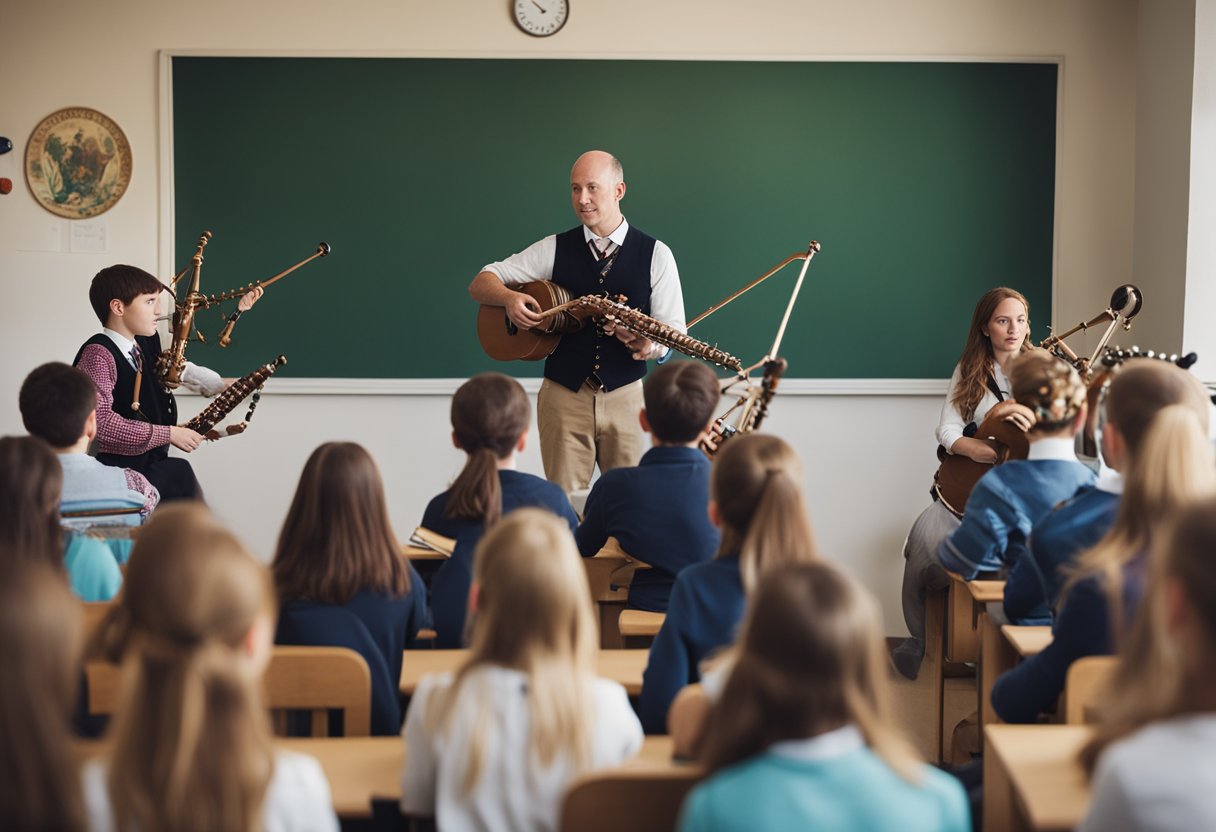
Learning to play the Uilleann pipes, a uniquely Irish musical instrument, is supported through dedicated teaching programmes and readily available educational resources. This ensures that the rich tradition of Uilleann piping continues to thrive and be accessible to new generations.
Teaching and Workshops
We recognise the importance of hands-on learning in the art of Uilleann piping. Organisations such as Na Píobairí Uilleann provide workshops and classes, imparting skills to students of various levels. The Willie Clancy Summer School is a celebrated event offering intensive courses led by esteemed pipers. In these settings, students not only learn the technical aspects of playing but also immerse themselves in the cultural context of the music.
Institutions and Resources
For those seeking structured learning, the Uilleann Pipe Academy and the Armagh Pipers Club are key institutions that nurture aspiring pipers. They offer a range of resources from beginner tutorials to advanced performance techniques. Both institutions maintain an extensive library of music and historic recordings, fostering a comprehensive educational environment for students.
Craftsmanship and Evolution
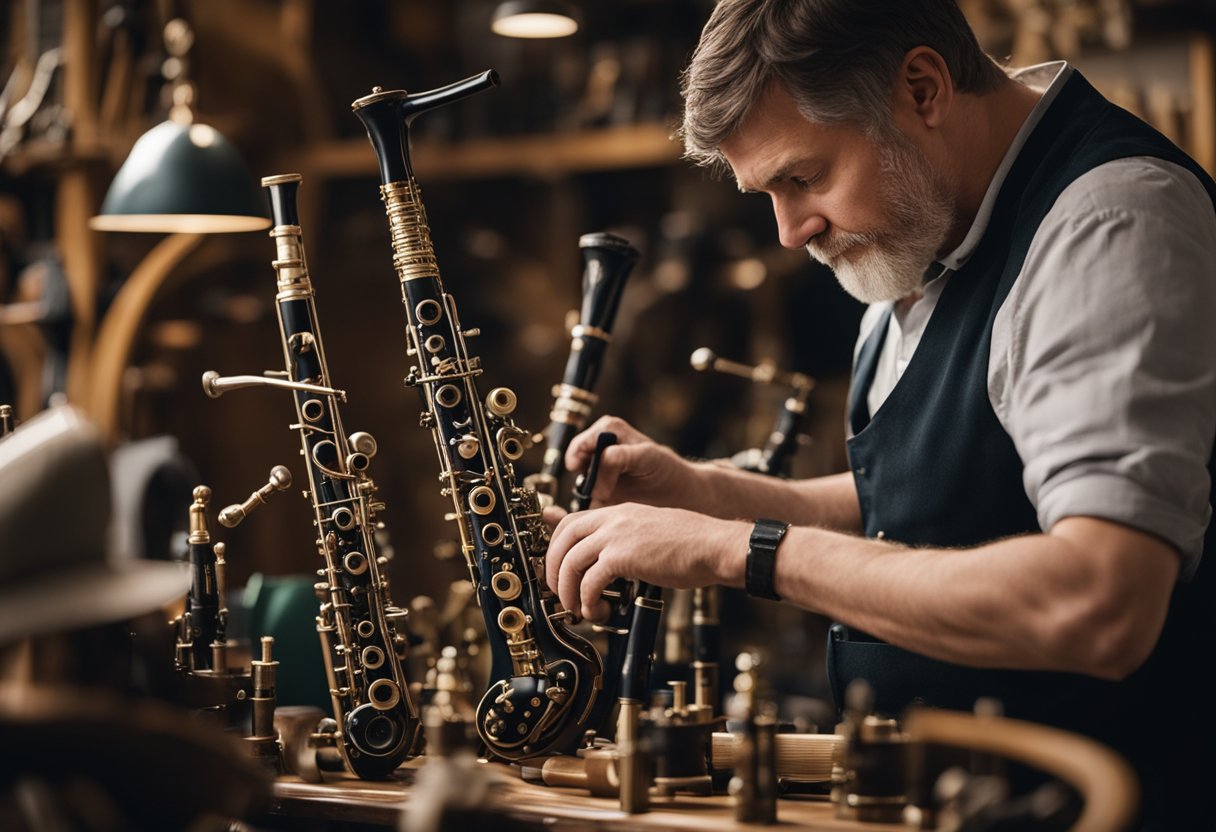
The Uilleann Pipes reflect an extraordinary blend of artistry and progression. We recognise the craftsmanship that has deepened their cultural imprint and the innovations that have propelled them from their traditional roots into the modern era.
Materials and Makers
Materials: The choice of materials in crafting Uilleann Pipes is pivotal for their quality and sound. Primarily, African Blackwood is favoured for its dense structure, lending the instrument a rich tone. Other woods like ebony and even more exotic varieties can be used, while fittings of brass and silver adorn the pipes.
Makers: Skilled pipe makers, some of whom have gained renown for their expertise, play a key role in the instrument’s evolution. Their dedication to quality and the nuances of the Uilleann Pipes’ design has preserved the instrument’s integrity through generations.
Innovation and Adaptations
Innovation: Advancements in technology have enabled innovation within the realm of the Uilleann Pipes. From precision tools to refined techniques, they’ve ushered in an era where the consistency and quality of these instruments are at their peak.
Adaptations: Historical cylinder recordings have provided a window into past techniques, influencing contemporary styles and playing methods. This has led to a dynamic evolution of the craft, blending time-honoured tradition with contemporary performance practices.
Global Influence
The Uilleann pipes have transcended boundaries, weaving a tapestry of musical tradition from Ireland to far-reaching corners of the world. As we examine their global influence, it’s evident that these pipes have played a musical role in the folk music scenes of Europe and beyond. Unlike their cousins, the Great Highland Bagpipes and the Scottish Smallpipes, the uilleann pipes offer a softer, more nuanced sound, which has enamoured audiences around the globe.
This unique Irish instrument has garnered attention due to efforts by the Gaelic League dedicated to preserving and promoting Irish culture. These movements have not only kept the tradition alive in Ireland but have also facilitated its spread worldwide. The uilleann pipes have become synonymous with Irish identity, thus playing a subtle yet significant part in global cultural exchanges.
- Europe: The pipes have found a special place in the Celtic music circles, uniting enthusiasts and musicians across various European nations.
- Global Influence: They inspire many artists, contributing to a vibrant world music community that interlaces different folk traditions.
Through festivals, workshops, and performances, these pipes consistently draw new devotees, embedding themselves in the fabric of world music. Our understanding and appreciation of this instrument further highlight our role in globally promoting and safeguarding such intangible cultural heritages.
Preservation Efforts
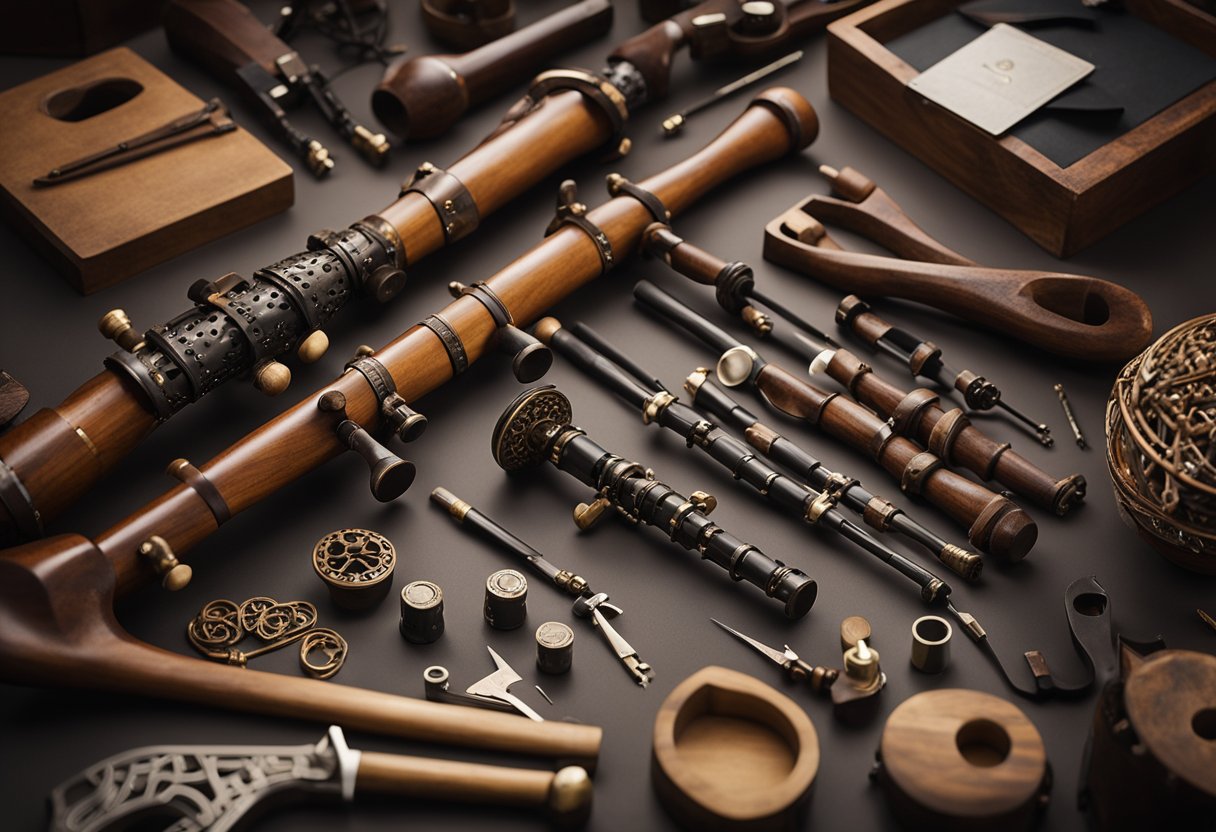
As stewards of our cultural heritage, we recognise the importance of preserving traditional arts, such as the Uilleann Pipes, a cornerstone of Irish music. We focus on safeguarding these musical traditions through concerted preservation efforts for future generations.
Organisations and Initiatives
To maintain the living tradition of Uilleann piping, several organisations work tirelessly. At the forefront is Na Píobairí Uilleann (NPU), an organisation dedicated to promoting and teaching Uilleann pipes. Through workshops, classes, and performances, NPU ensures ongoing skills and knowledge transmission. Additionally, we collaborate with other cultural institutions to facilitate access to Uilleann piping and support pipers at every level of expertise.
Recognition and Safeguarding
On a larger scale, the preservation of Uilleann piping has garnered international attention. In early December 2017, Uilleann Piping was honoured on the Representative List of the Intangible Cultural Heritage of Humanity by UNESCO, a recognition that celebrates and helps safeguard this unique aspect of our cultural heritage. The inclusion exemplifies efforts to protect the art form as an Intangible Cultural Heritage, ensuring it remains a vibrant feature of Irish identity. The United Nations Educational, Scientific and Cultural Organisation is instrumental in these initiatives, promoting the safeguarding of intangible heritage around the globe and championing its transmission to new generations.
Modern Uilleann Piping
Recently, Uilleann piping has seen a remarkable revival, with professional pipers leading a resurgence that redefines musical styles.
Professional Pipers
Today’s professional pipers stand on the shoulders of giants, preserving the age-old craft while infusing it with contemporary influences. Artists like Cillian Vallely, a virtuoso on the pipes and a torchbearer of tradition, exemplify this delicate balance. Vallely, known for his role in the acclaimed band Lúnasa, showcases his profound skills through a discography that spans over two decades. Their music embodies a blend of historical reverence and modern sophistication.
Resurgence and the Future
The resurgence of interest in Uilleann pipes is preserving Irish culture and spearheading its future within the world music scene. Once on the brink of obscurity, the distinct sound of the Uilleann pipes is now a celebrated component of Irish identity. The intrigue around the instrument and its capability to convey a spectrum of emotions has led to a new wave of performers and audiences alike eager to experience its soul-stirring melodies. This interest has catalysed a global community committed to the sustainability and proliferation of Uilleann piping, ensuring its place in the fabric of world music for generations to come.
Frequently Asked Questions
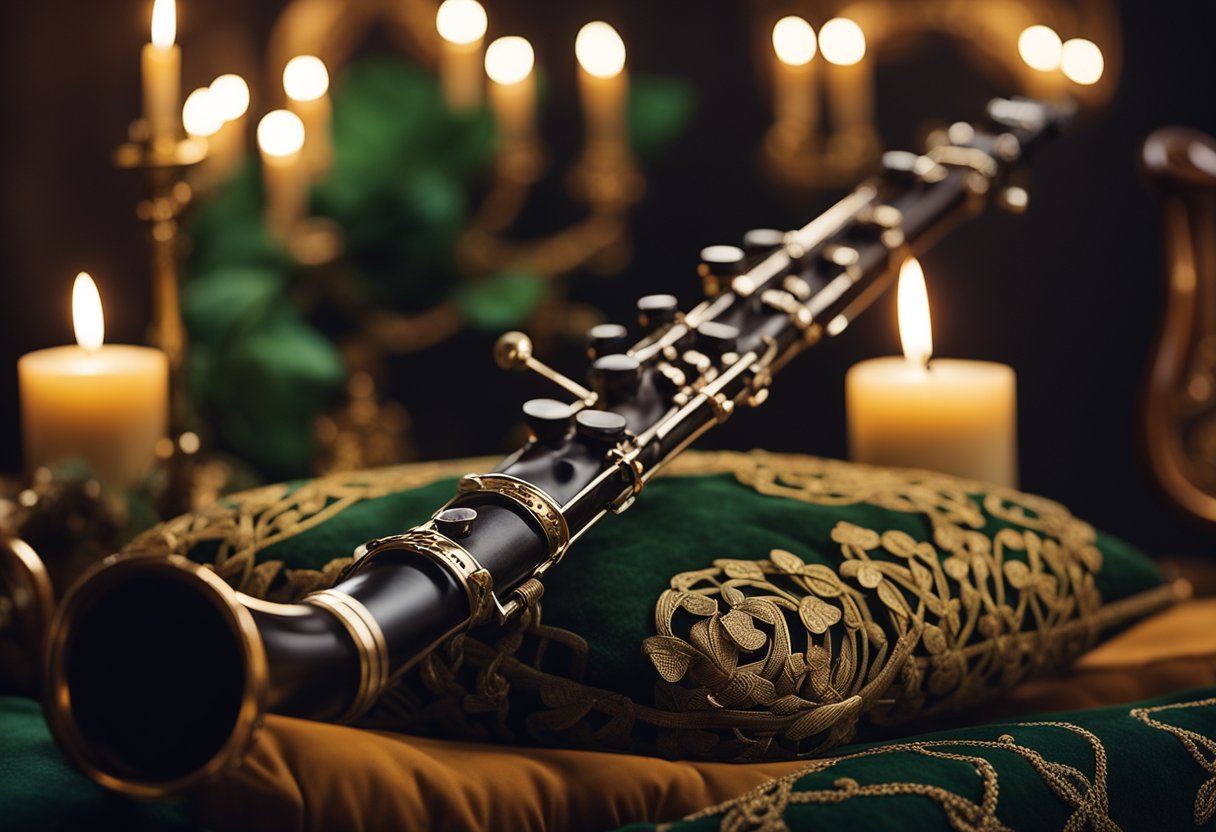
As we explore the distinctive sound of Ireland’s traditional music scene, we focus on the uilleann pipes, a symbol of Irish heritage and a beloved instrument with a rich history.
How are the uilleann pipes traditionally played?
To play the uilleann pipes, one uses a combination of coordinated hand movements on the chanter and regulates airflow with bellows strapped to the arm. The musician exerts pressure on the bag with the elbow, earning it the name ‘uilleann’, the Irish word for ‘elbow’.
Who is credited with the invention of the uilleann pipes?
The uilleann pipes are not attributed to a single inventor but evolved. Initially, they were referenced as ‘Union pipes’ in the 18th century, signalling their development from earlier forms of bagpipes.
In what ways do the uilleann pipes differ from other types of bagpipes?
Uilleann pipes are unique in their design and playing technique. They are bellows-blown, not mouth-blown, and have a wider range of notes. Their gentle sound is more controlled than other bagpipes’ powerful sound.
Can you trace the origins of the uilleann pipes?
Yes, the origins of the uilleann pipes can be traced back to the early 18th century. They evolved from the pastoral or ‘parlor’ pipes and were well established by the late 1700s in Ireland.
What is the significance of the uilleann pipes within Irish culture?
The uilleann pipes are a defining element of Irish traditional music and culture. They have a symbolic presence in Irish history and continue to be cherished for their complex, emotive sound that can convey a wide range of feelings, from joy to sorrow.
Who are some of the renowned players of the uilleann pipes from Ireland?
There are several renowned uilleann pipers from Ireland, including Cillian Vallely, who is known for his work with the band Lúnasa and has contributed significantly to the tradition of Irish music.





